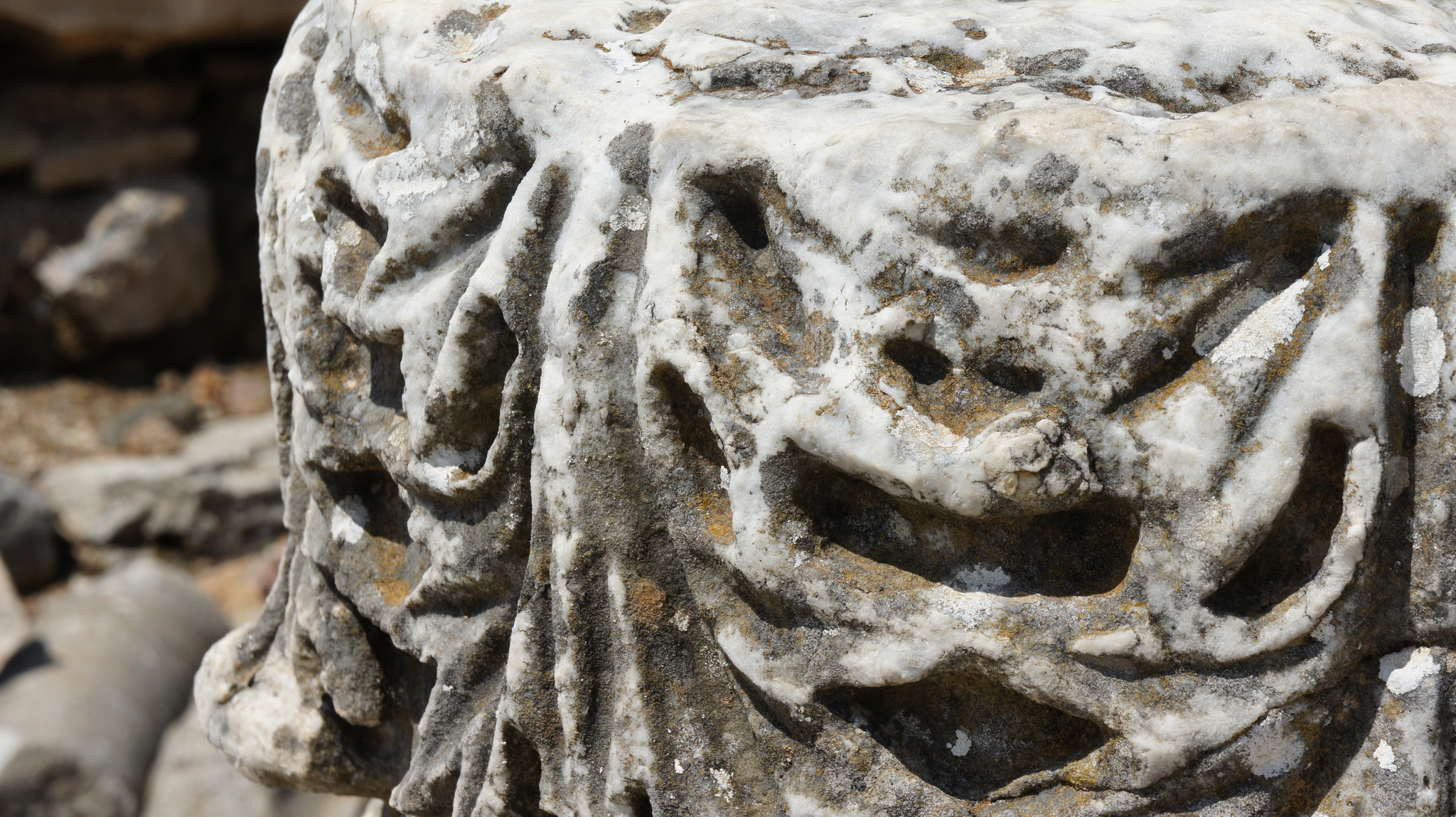
Image: Flickr/brownpau
I met Ruth Koppek in Chitchen Itza, Mexico, on Ix, the day of the Jaguar. We’d climbed different sides of a Mayan calendar pyramid, one with four sets of stairs of ninety-one steps each, and ran into each other only when we’d arrived at the top. She got there before I did and had her back to me as she looked out over the trees and plain. She had a long stiff braid down her back. It was never undone. You could imagine it dipped in tar as pirates did who found this procedure easier than washing. She pointed to Eb, a figure with an angular face, a long hard jawline, associated with rainstorms. Nearby was Oc, thirteen, a lucky number, the dog who acted as a beacon, guiding the night sun through the underworld.
According to Mayan creation myth, Ruth said, the gods discovered yellow and white corn, the ideal essence from which men could be made. Four corn men were created, and they turned out better than expected, flawless creations with perfect vision and comprehension of the world. The gods felt uneasy about the corn people’s close resemblance to themselves, so in order to make men more fallible, their gifts were deliberately diminished. After their powers were adjusted, the corn men were given four corn women, one each.
Leaning against a huge limestone serpent with a human face staring out of its mouth she told me that she had once stolen something from a site. It was at a tomb in a border state few people visited. Looters had dug a tunnel into it and so had gone about their work undetected. Bones were strewn around, bits and pieces of pottery were scattered into random corners and heaps. Nearly everything had been taken from the site, but she found a nose ring which depicted a little man wearing an identical nose ring in a piece of a mise an abime puzzle of which only a living human nose was absent. Pieces of frieze that had been chiseled off walls lay on the ground, and when she put the pieces together the result were images of men and women intertwined, ancient pornography, maybe. The images themselves, rendered in burnt limestone rubble and marl, might have been a joke planted by the looters who were hungry and wouldn’t have bothered with things that couldn’t be sold, but she also imagined the middlemen, the dealers with residences in New York, London, Tokyo who wanted to leave a message, as if to say: dusty digging knuckleheads with your brains full of clan relationships and calendars, it all comes down to this: screwing. She pocketed the nose ring and a figure of little man with an enormous dick then and walked away from the site, never to return.
“Look,” she opened her hand, and the little figure lay nestled in her palm.
Later Ruth marched ahead of me, map folded into back pocket humming My World is Empty Without You, Babe combined with the Perry Mason theme song, as performed by the Del Byzanteens, but nodding her head back and forth in a way Phil Kline probably never did. The rhythm of walking hacking your way through the jungle, heavy deliberate steps, kind of lends itself to the Perry mason theme song, if you think about it. The advocate of the concrete and knowable kept an amulet, a small silver fish, round her neck. Ruth’s grandmother had given it to her to ward off the evil eye, and she believed in it completely. The two inches of silver scales and blue beady eyes was never removed. (I tried once and was pushed away.) Stumbling over a vine sometimes I let her get ahead of me and completely out of sight just to get a break from her sureness and confidence. I was somebody’s graduate assistant. What did I know?
One evening when we were still out and darkness was falling fast not leaving usmuch time to get back to town, in an effort to talk to her, I tried to make the following point. Even the edifice of provable facts is within lasso reach of any itinerant fantasist. The chacmools she studied, for example, with their languid reclining bodies and sphinx-like faces, bearing stone trays to support human sacrifice were named by an eccentric nineteenth century Frenchman, Augustus Le Plongeon, who christened the things he found according to his own random system as he traveled with an assortment of the concertina-shaped cameras of the era, and a monkey who carried his own private embossed leather satchel. Ruth shrugged her narrow shoulders, spades and compass jangling from her backpack. How long does a human heart keep beating after it’s pulled out of a chest cavity? How long does the person whose aortas and ventricles dangle above their face remain in sentient terror?
“Plongeon spoke to the monkey as if it were a co-antiquarian, trained in a lycee. The little fellow had its own monogrammed trowel and ate with him in the dining car. ” I said.
Ruth scratched an ankle where she’d been bitten by a mosquito. One of Ruth’s eyes was slightly bigger than the other so that I sometimes wondered if two different personalities lodged behind them: one who had no argument with a monkey in the dining car, and the other who called the conductor to complain and spoke to him in his own south Mexican Spanish. The it’s really no big deal eye shared the cranium space with this is entirely unacceptable. So, I think part of her would have traveled through swarms of locusts with me while the other half never imagined she inflicted a thousand cuts with one snicker.
“He retired to Brooklyn where he died in 1908 with a view of the East River.” Ruth countered.
It was true. Laughed at, his theories in disgrace, Le Plongeon and his wife retreated to Brooklyn. Even in retirement Le Plongeon still claimed a dethroned Mayan queen fled to Egypt on a winged boat, and that the city of Palenque sent ambassadors to Polynesia.
Like Le Plongeon, I found something compelling in the idea of going full steam ahead and building an entire universe out of flotsam and jetsam: grab a barque known to the Nile delta region, a Mayan nose ring, a Berlin U-bahn ticket with a faces drawn on one side, a giant sandstone ashtray that could also serve as a vessel for containing a human heart rendered in sacrifice, tie all the pontoons together and walk across the Mississippi. Why not? I asked Ruth which was mostly like asking the air. We were traveling with a few others, but at this point our team was far ahead and not visible. There’s a feeling you get when walking in remote places that someone is watching you, someone you can’t see who travels on a ridge to your right, over your shoulder, who hides behind thick palms or blends with a screen of vines. We were in the jungle to find what we could, while all the while some one or group of people was watching us, even if it was a tribe without written language, someone was noting how this man and woman talked loudly, gestured, didn’t seem to get along or agree about anything and sprayed the air from time to time with some kind of mist that came out of a metal cylinder. How had the Le Plongeons plunged on, perhaps along this exact route and remained adoring of one another’s schemes and inventions?
Together Le Plongeon and his wife created a box made up of compartments which could be reassembled to form a portable dark room complete with sink and black curtain, impervious to sunlight. Two people could set it up in less than five minutes. Something carried in a bag you could snap open almost with little more than a flick of the wrist, the anonymous black box, was converted into a complicated functional structure. The same imagination that gave life to chacmools and studied monkey chatter invented some very practical things as well. Couldn’t you be a crackpot, your ideas held up to ridicule, and still be happy? I fished in my pocket for a jack knife traced the outline of a glyph in stone until Ruth told me to stop. The noise of the blade against rock was irritating.
Ruth shook the bottle of Rambug she’d bought at a camping store and sprayed the chemical-infusion not just on herself but into the air. As far as she was concerned the discussion was over. She had the world on a string. Walking far ahead of me she relegated nineteenth century antiquarians and their cabinets of curiosities to useless storage. An emerald green snake hung knotted from a branch overhead. Ruth eyed it with a raised eyebrow before walking underneath. I’d seen her lop the head off a rattler that came too close and do so in a blink, then move on as if she’d done nothing more than swat a mosquito. Members of the reptile family didn’t occupy her nightmares. These were inhabited by other phantoms as I would eventually learn. She was afraid of the interiors of local churches, hollowed out, they contained no pews or benches of any kind. Incense burned and people came and went, lighting candles and chanting before saints, offering Coke or Fanta, eggs, or a dead chicken. The saints were lined up along the walls, and each had a mirror hung around his or her neck to keep evil away, and no, Ruth wasn’t some kind of reincarnated demon. She just felt creeped out by churches.
Imagine being interviewed on a television show and when asked how you met the person you married, you have to say you collided at the top of a Mayan calendar pyramid. The audience is cued for laughter, the interviewer raises his eyebrows. He thinks you’re making this up. We stayed in Mexico for a year, then moved back to New York.
This excerpt is from a forthcoming novel, The Lost Civilization of Suolucidir, to be published by City Lights.
***
 Susan Daitch is the author of four novels and a collection of short fiction. Her work has appeared in Guernica, Conjunctions, Slice, Black Clock, and elsewhere. She lives in Brooklyn with her son.
Susan Daitch is the author of four novels and a collection of short fiction. Her work has appeared in Guernica, Conjunctions, Slice, Black Clock, and elsewhere. She lives in Brooklyn with her son.
